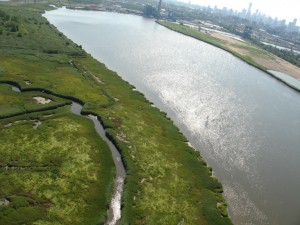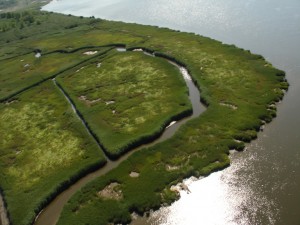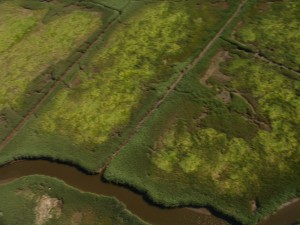Category: Candidate Restoration/Preservation Site 
Location: Directly adjacent to the Malanka landfill to the east, to the Hackensack River to the west and south, and south of the Laurel Hill Park Wetland site in Secaucus, Hudson County.
Latitude/Longitude: 40.75312/-74.08973
Current Land Use: Tidal marsh
Size: 57 acres
Current Ownership: NJMC
Site Description: Riverbend Wetlands Preserve is undeveloped but is directly adjacent to the Malanka Landfill. Mosquito ditches were dug at the site in the 1920’s and 1930’s. Portions of the site currently support a mixture of native high saltmarsh vegetation, dominated by saltmarsh hay (Spartina patens). Other areas consist of open water and dense monocultures of common reed (Phragmites australis). Rutgers University uses the site as a reference study site due to the presence of native high marsh vegetation. The site was purchased by NJMC in December 1996. NJMC has since prepared a preliminary wetland enhancement design and developed a scope of the work for baseline studies at the site. Preliminary evaluation of the open marsh water technique has been completed and presented to the jurisdictional agencies. A restoration design is being developed based on open marsh water management, and the baseline studies scope of work is being modified to ensure consistency with the OMWM requirements. This site has also been known as the South Secaucus Site.
Existing Site-Specific Data Inventory
A. Survey, Maps, and GIS
HMD regional data exists inclusive of this site.
B. Real Estate/Ownership
Owned by NJMC. Acquisition data available on NJMC website.
C. Site History & Land Use
The ACOE completed a cultural resource investigation of this site in 2006.
D. Biological Studies – Fauna
Monitoring conducted in 2001.
E. Biological Studies – General Environmental
Site-specific baseline data collected in 1990 and 1992. Monitoring conducted in 2001. Phragmites australis studies were conducted from 2000-2003. Wetland assessments conducted in 1990, 1993, and 2003.
F. Geotechnical
No data obtained.
G. Hydraulics and Hydrology
No data obtained.
H. Water and Sediments
Site-specific sediment sampling and analyses conducted in 1982 and 2001.
I. Historical/Cultural Resources
No data obtained.
J. Restoration/Remediation Design Plans
Conceptual restoration plan developed in 1986.
Site Reports
Site #26 – Riverbend Wetlands Preserve
Category: Candidate Restoration/Preservation Site
Location: Directly adjacent to the Malanka landfill to the east, to the Hackensack River to the west and south, and south of the Laurel Hill Park Wetland site in Secaucus, Hudson County.
Latitude/Longitude: 40.75312 / -74.08973
Current Land Use: Tidal marsh
Size: 57 acres
Current Ownership: NJMC
Site Description: Riverbend Wetlands Preserve is undeveloped but is directly adjacent to the Malanka Landfill. Mosquito ditches were dug at the site in the 1920’s and 1930’s. Portions of the site currently support a mixture of native high saltmarsh vegetation, dominated by saltmarsh hay (Spartina patens). Other areas consist of open water and dense monocultures of common reed (Phragmites australis). Rutgers University uses the site as a reference study site due to the presence of native high marsh vegetation.
The site was purchased by NJMC in December 1996. NJMC has since prepared a preliminary wetland enhancement design and developed a scope of the work for baseline studies at the site. Preliminary evaluation of the open marsh water technique has been completed and presented to the jurisdictional agencies. A restoration design is being developed based on open marsh water management, and the baseline studies scope of work is being modified to ensure consistency with the OMWM requirements. The site has also been known as the South Secaucus Site.
Existing Site Specific Data Inventory
* – Report repeated under multiple data categories and/or sites.
A. Survey, Maps, and GIS
Relevant survey, mapping, and GIS data for the Meadowlands can be found in the Meadowlands-wide site report under data category A.
B. Real Estate/Ownership
Riverbend Wetlands Preserve is owned by NJMC.
1. NJMC. Riverbend Wetlands Preserve Acquisition Information. September 2003.
(from http://www.hmdc.state.nj.us/eip/wl-riverbend.html)
Date of Acquisition: December 20, 1996
Cost of Acquisition: $475,000
Acquired from: Hartz Mountain Industries
C. Site History & Land Use
The ACOE completed a cultural resource investigation of this site in 2006.
D. Biological Studies – Fauna
2. *Donald J. Smith Environmental Consultants. Monthly Report: Harrier Meadow, Mill Creek, Skeetkill Creek Marsh, Oritani Marsh, Riverbend Wetlands Preserve and Secaucus High School. August 2001. [1a] Monthly observation report summarizing site conditions, management recommendations, and wildlife monitoring data at the Harrier Meadow, Mill Creek, Skeetkill Creek Marsh, Oritani Marsh, Riverbend Wetlands Preserve, and Secaucus High School sites. Includes photographs documenting environmental conditions.
3. *Donald J. Smith Environmental Consultants. Monthly Report: Harrier Meadow, Mill Creek, Skeetkill Creek Marsh, Oritani Marsh, Riverbend Wetlands Preserve and Secaucus High School. September 2001. [1a] Monthly observation report summarizing site conditions, management recommendations, and wildlife monitoring data at the Harrier Meadow, Mill Creek, Skeetkill Creek Marsh, Oritani Marsh, Riverbend Wetlands Preserve, and Secaucus High School sites. Includes photographs documenting environmental conditions.
E. Biological Studies – General Environmental
4. *Bart, D. Environmental Determinants of Phragmites australis Invasion in a New Jersey Salt Marsh: Interactions Among Human Activities, Disturbance, and Edaphic Conditions. Rutgers University. 2003. [5] Tested ability of common reed (Phragmites australis) to establish itself in poorly drained saline environments through burial of large rhizomes, periods of low salinity, and localized drainage.
5. *Bart, D. & J.M. Hartman. Environmental Constraints on Early Establishment of Phragmites australis in Salt Marshes. Wetlands. Volume 22 No. 2 pp. 201-213. 2002. [5] Effects of rhizome burial, salinity, anoxia, and sulfides on emergence, survival, growth, biomass production, and spread of common reed (Phragmites australis) were examined in greenhouse and field experiments.
6. *Bart, D. and J.M. Hartman. Environmental Determinants of Phragmites australis Expansion in a New Jersey Salt Marsh: An Experimental Approach. Oikos. 89:59-69. 2000. [1a] Examined the effects of drainage and sulfides on common reed (Phragmites australis). Three experimental treatments were performed on Phragmites plants: 1) the previous year’s dead stems were clipped to limit aeration; 2) rhizomes were severed to prevent translocation; and 3) both previous year’s dead stems were clipped and rhizomes were severed. A control set was left undisturbed.
7. *Bart, D. & J.M. Hartman. The Role of Large Rhizome Dispersal and Low Salinity Windows in the Establishment of Common Reed, Phragmites australis, in Salt Marshes: New Links to Human Activities. Estuaries. Volume 26 No. 2B pp. 436-443. 2003. [5] Tested ability of common reed (Phragmites australis) to establish itself in poorly drained saline environments through burial of large rhizomes, periods of low salinity, and localized drainage.
8. *Donald J. Smith Environmental Consultants. Monthly Report: Harrier Meadow, Mill Creek, Skeetkill Creek Marsh, Oritani Marsh, Riverbend Wetlands Preserve and Secaucus High School. August 2001. [1a] Monthly observation report summarizing site conditions, management recommendations, and wildlife monitoring data at the Harrier Meadow, Mill Creek, Skeetkill Creek Marsh, Oritani Marsh, Riverbend Wetlands Preserve, and Secaucus High School sites. Includes photographs documenting environmental conditions.
9. *Donald J. Smith Environmental Consultants. Monthly Report: Harrier Meadow, Mill Creek, Skeetkill Creek Marsh, Oritani Marsh, Riverbend Wetlands Preserve and Secaucus High School. September 2001. [1a] Monthly observation report summarizing site conditions, management recommendations, and wildlife monitoring data at the Harrier Meadow, Mill Creek, Skeetkill Creek Marsh, Oritani Marsh, Riverbend Wetlands Preserve, and Secaucus High School sites. Includes photographs documenting environmental conditions.
10. *The Louis Berger Group, Inc. Hydrogeomorphic (HGM) Functional Assessment Model and Guidebook for Tidal Fringe Wetlands in the New Jersey Meadowlands. 2003. [1a](http://merilibrary.meadowlands.state.nj.us/dbtw-wpd/FullText/HGM_guidebook_RVSD.pdf) A hydrogeomorphic functional assessment model and guidebook for tidal fringe wetlands in the Hackensack Meadowlands was completed. The HGM model can be used as a tool to help determine wetland functions and values and to approximate compensatory wetland mitigation. Map-based and on-site field data (including amount of aquatic edge, channel density, vegetative cover, habitat, soil texture, and tidal inundation) were collected from the reference wetlands and used to refine data collection forms, calibrate model variables, and improve the conceptual HGM functional models. Reference sites included Skeetkill Creek Marsh, Meadowlark Marsh, Lyndhurst Riverside Marsh, MRI, Western Brackish Marsh, Mill Creek Marsh, Eastern Brackish Marsh, Mori Tract, Walden Marsh, Oritani Marsh, Harrier Meadow, Anderson Creek Marsh, Kearny Brackish Marsh, and Riverbend Wetlands Preserve.
11. *TAMS Consultants, Inc. Comprehensive Baseline Studies, IR-2 and Off-Site Mitigation Areas/Evaluation of the Harmon Meadow Western Brackish Marsh Mitigation Area. June 1990. [2] Baseline studies were initiated in 1986 to provide Hartz Mountain Industries with planning information about three proposed mitigation sites – IR-2 onsite mitigation (now known as Western Brackish Marsh), Anderson Creek Marsh, and South Secaucus (also known as Riverbend Wetlands Preserve) – by documenting existing ecological conditions of the sites and the Hackensack River in their vicinity for a year-long period.
12. *TAMS Consultants, Inc. Functional Evaluation of the Villages at Mill Creek Development and Mitigation Sites. March 1993. [2] Qualitatively evaluates the functional opportunity/effectiveness of wetlands at four sites – IR-2 (now the Mill Creek Wetland Mitigation Site), Anderson Creek Marsh, South Secaucus (also known as Riverbend Wetlands Preserve), and Meadowlark Marsh – based on physical, chemical, and biological attributes.
13. *TAMS Consultants, Inc. Habitat Evaluation Procedure (HEP): IR-2 Site and Off-Site Mitigation Areas: Evaluation of the Villages at Mill Creek Mitigation Program. October 1990. [2] The HEP was used to quantify the habitat value of the proposed IR-2 site (now the Mill Creek Wetland Mitigation Site) and mitigation area (now Western Brackish Marsh), as well as two potential offsite wetland mitigation sites – Anderson Creek Marsh and South Secaucus (also known as Riverbend Wetlands Preserve).
14. *TAMS Consultants, Inc. Technical Report on Vegetation Mapping for IR-2, Anderson Creek Marsh, and South Secaucus Wetland Sites. December 1990. [2]Presents vegetation mapping with supporting data for the IR-2 site (now the Mill Creek Wetland Mitigation Site), its potential onsite mitigation area (now Western Brackish Marsh), and potential offsite mitigation areas – Anderson Creek Marsh and South Secaucus (now known as Riverbend Wetlands Preserve).
15. *TAMS Consultants, Inc. The Villages at Mill Creek (IR-2) Wetland Evaluation Technique (WET) Assessment (Draft). February 1990. [2]A WET functional wetlands value assessment was undertaken in response to a condition of the USACE draft permit for this project. This WET assessment evaluated existing and future conditions at the IR-2 site (now the Mill Creek Wetland Mitigation Site), as well as the potential mitigation sites – Anderson Creek Marsh and South Secaucus (also known as Riverbend Wetlands Preserve). Social significance and functional effectiveness/opportunity of wetlands were evaluated.
16. *USEPA and Gannett Fleming, Inc. Site Survey Report: Ecological Studies: Hartz Mountain Development Corporation Villages at Mill Creek. October 1992. [2]Presents results of a fourteen-week field study designed to evaluate the existing conditions of bird and aquatic ecology at the Villages at Mill Creek site (now the Mill Creek Wetland Mitigation Site), as well as the proposed mitigation areas for the fill activity at the site – Anderson Creek and South Secaucus (also known as Riverbend Wetlands Preserve).
F. Geotechnical
No data obtained.
G. Hydraulics and Hydrology
No data obtained.
H. Water and Sediments
17. TAMS Consultants, Inc. Riverbend Wetlands Preserve: Sampling and Analyses of Sediment. June 11, 2001. [2a]Sediment sampling and analysis was conducted at the Riverbend Wetlands Preserve. Samples were collected from 15 locations – ten within on-site creeks and five within the marsh plain – on April 26, 27, and 28, 2001. As composite and duplicates were included, a total of 28 samples were analyzed.
18. Torlucci, Joseph Jr. Distribution of Heavy Metal Concentrations in Sediment Surrounding a Sanitary Landfill in the Hackensack Meadowlands, NJ. Rutgers University, Newark. 1982. [1a] Collected sediment cores surrounding the “Mall” Landfill (aka Malanka Landfill) in Secaucus and analyzed for metals. Compared concentrations to other landfills and analyzed vertical gradient.
I. Historical/Cultural Resources
The ACOE completed a cultural resource investigation of this site in 2006.
J. Restoration/Remediation Design Plans
19. *TAMS Consultants, Inc. The Villages at Mill Creek (IR-2) Brackish Wetland Mitigation Concept. May 1986. [2] Quantifies the net impact of filling 97.41 acres of USACE-regulated wetlands and enhancing 91.98 acres for the construction of the proposed Villages at Mill Creek.
K. Bibliographic Updates
Site #26: Riverbend Wetlands Preserve
Additional Images



